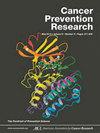求助PDF
{"title":"Editors' Selections from Relevant Scientific Publications","authors":"","doi":"10.1158/1940-6207.capr-16-8-hfl","DOIUrl":null,"url":null,"abstract":"Highlights from the Literature| August 01 2023 Editors' Selections from Relevant Scientific Publications Author & Article Information Online ISSN: 1940-6215 Print ISSN: 1940-6207 ©2023 American Association for Cancer Research2023American Association for Cancer Research Cancer Prev Res (Phila) (2023) 16 (8): 419. https://doi.org/10.1158/1940-6207.CAPR-16-8-HFL Views Icon Views Article contents Figures & tables Video Audio Supplementary Data Peer Review Share Icon Share Facebook Twitter LinkedIn Email Tools Icon Tools Get Permissions Cite Icon Cite Search Site Article Versions Icon Versions Version of Record August 1 2023 Citation Editors' Selections from Relevant Scientific Publications. Cancer Prev Res (Phila) 1 August 2023; 16 (8): 419. https://doi.org/10.1158/1940-6207.CAPR-16-8-HFL Download citation file: Ris (Zotero) Reference Manager EasyBib Bookends Mendeley Papers EndNote RefWorks BibTex toolbar search Search Dropdown Menu toolbar search search input Search input auto suggest Search Advanced Search Polygenic risk scores for screening (from Centers for Disease Control and Prevention) Using UK metrics, Huntley et al. conducted a modeling analysis on the performance of polygenic risk score (PRS) tools and PRS-stratified cancer screening. They estimated the potential annual numbers of cancer cases detected and deaths averted for eight different cancers. The results suggested that, under favorable assumptions, hypothetical PRS-stratified screening programs could modestly improve efficiency for three cancer types. Specifically, they could reduce maximum number of annual deaths from 102 to 80 for breast cancer, 188 to 155 for prostate cancer, and 158 to 95 for colorectal cancer. However, UK-specific cluster-randomized trials are required to evaluate the real-world clinical impact, costs, and potential harm of PRS stratification. Huntley C, … Turnbull C. Lancet Oncol. 2023 Jun;24(6): 658-668. Illustration of deep learning (by OpenClipart via FreeSVG) Pancreatic cancer is often diagnosed too late to achieve good clinical outcomes,... You do not currently have access to this content.","PeriodicalId":9373,"journal":{"name":"Cancer Prevention Research","volume":"43 1","pages":"0"},"PeriodicalIF":2.9000,"publicationDate":"2023-08-01","publicationTypes":"Journal Article","fieldsOfStudy":null,"isOpenAccess":false,"openAccessPdf":"","citationCount":"0","resultStr":null,"platform":"Semanticscholar","paperid":null,"PeriodicalName":"Cancer Prevention Research","FirstCategoryId":"1085","ListUrlMain":"https://doi.org/10.1158/1940-6207.capr-16-8-hfl","RegionNum":3,"RegionCategory":"医学","ArticlePicture":[],"TitleCN":null,"AbstractTextCN":null,"PMCID":null,"EPubDate":"","PubModel":"","JCR":"Q2","JCRName":"ONCOLOGY","Score":null,"Total":0}
引用次数: 0
引用
批量引用
编辑对相关科学出版物的选择
文献亮点| 2023年8月1日编辑精选相关科学出版物作者与文章信息在线ISSN: 1940-6215印刷ISSN: 1940-6207©2023美国癌症研究协会2023美国癌症研究协会癌症预防研究(费城)(2023)16(8):419。https://doi.org/10.1158/1940-6207.CAPR-16-8-HFL查看图标查看文章内容图表和表格视频音频补充数据同行评审共享图标共享Facebook Twitter LinkedIn电子邮件工具图标工具获得权限引用图标引用搜索网站文章版本图标版本记录版本2023年8月1日引文编辑从相关科学出版物的选择。癌症预防中心(费城)2023年8月1日;16(8): 419。https://doi.org/10.1158/1940-6207.CAPR-16-8-HFL下载引文文件:Ris (Zotero) Reference Manager EasyBib Bookends Mendeley Papers EndNote RefWorks BibTex工具栏搜索搜索下拉菜单工具栏搜索搜索输入搜索输入自动建议搜索高级搜索筛选多基因风险评分(来自疾病控制和预防中心)使用英国指标,Huntley等人对多基因风险评分(PRS)工具和PRS分层癌症筛查的性能进行了建模分析。他们估计了八种不同癌症每年可能发现的癌症病例和避免的死亡人数。结果表明,在有利的假设下,假设的prs分层筛查方案可以适度提高三种癌症类型的效率。具体来说,他们可以将每年乳腺癌死亡人数从102人减少到80人,前列腺癌死亡人数从188人减少到155人,结肠直肠癌死亡人数从158人减少到95人。然而,需要英国特定的集群随机试验来评估PRS分层的实际临床影响、成本和潜在危害。张建军,张建军,张建军,等。中华医学杂志,2013,31(6):658-668。胰腺癌通常诊断得太晚,无法获得良好的临床结果。您目前没有访问此内容的权限。
本文章由计算机程序翻译,如有差异,请以英文原文为准。


